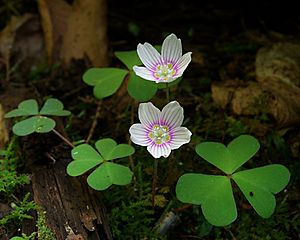Mountain woodsorrel facts for kids
Quick facts for kids Mountain woodsorrel |
|
|---|---|
 |
|
| Conservation status | |
| Scientific classification | |
| Genus: |
Oxalis
|
| Species: |
montana
|
Oxalis montana is a small flowering plant. It belongs to the Oxalidaceae family. People call it by many names like mountain woodsorrel, wood shamrock, sours, and white woodsorrel. Sometimes it's also called common woodsorrel, but that name can also mean a similar plant, Oxalis acetosella.
This plant grows naturally in eastern North America. You can find it in eastern Canada and the central and eastern United States. It also grows in the Appalachian Mountains. The second part of its scientific name, montana, means "from the mountains."
What Oxalis Montana Looks Like
Oxalis montana is a plant that lives for many years. It grows in groups connected by underground stems called rhizomes. It doesn't have a main stem above ground. Instead, its leaves grow in clumps. These clumps can reach about 10 centimeters (4 inches) tall.
Each leaf is made of three small, heart-shaped parts called leaflets. These leaflets can move! They fold up and unfold depending on how much sunlight they get.
This plant has two kinds of flowers. Some flowers open up, like most flowers you see. But others are called cleistogamous flowers. These flowers stay closed and pollinate themselves. The color of the open flowers can be different. For example, flowers growing high up in the mountains often have lighter colored veins on their petals. Flowers growing lower down usually have deeper pink-purple veins.
The fruit of the plant is a small case called a capsule. The plant makes new plants in two ways. It can make seeds, which is called sexual reproduction. It can also grow new groups of plants from its underground rhizomes. This is called asexual reproduction. Sometimes, a group of these plants might not make any flowers in a year. In that case, they only reproduce using their rhizomes.
Where Oxalis Montana Lives
This plant is a "climax species." This means it grows well in old, established forests. It can also handle a lot of shade. It is a very common plant in many forest ecosystems. For example, it grows a lot in the forests of the Appalachian Mountains. There, you can find it growing under trees like red spruce (Picea rubens) and balsam or Fraser fir (Abies balsamea or A. fraseri).
It also grows a lot in "northern hardwood forests." These are forests with trees like red or sugar maple (Acer rubrum or A. saccharum), yellow birch (Betula lutea), and American beech (Fagus grandifolia). Other common plants growing with Oxalis montana include false lily-of-the-valley (Maianthemum canadense), goldthread (Coptis groenlandica), starflower (Trientalis borealis), and woodferns (Dryopteris species).
The many roots of Oxalis montana help to hold the soil in place. This can stop the soil from washing away. It can grow on flat ground or on very steep hills. The places where it grows are often cool and wet. They have high humidity and a lot of rain. They also get "fog drip," which is water from fog. Sometimes, snow stays on the ground for a long time. Forest fires are not common in these areas.
Uses of Oxalis Montana
This plant has a sour taste. You can add it to soups or salads. But be careful! It contains something called oxalic acid. This acid can be harmful if you eat too much of it.


